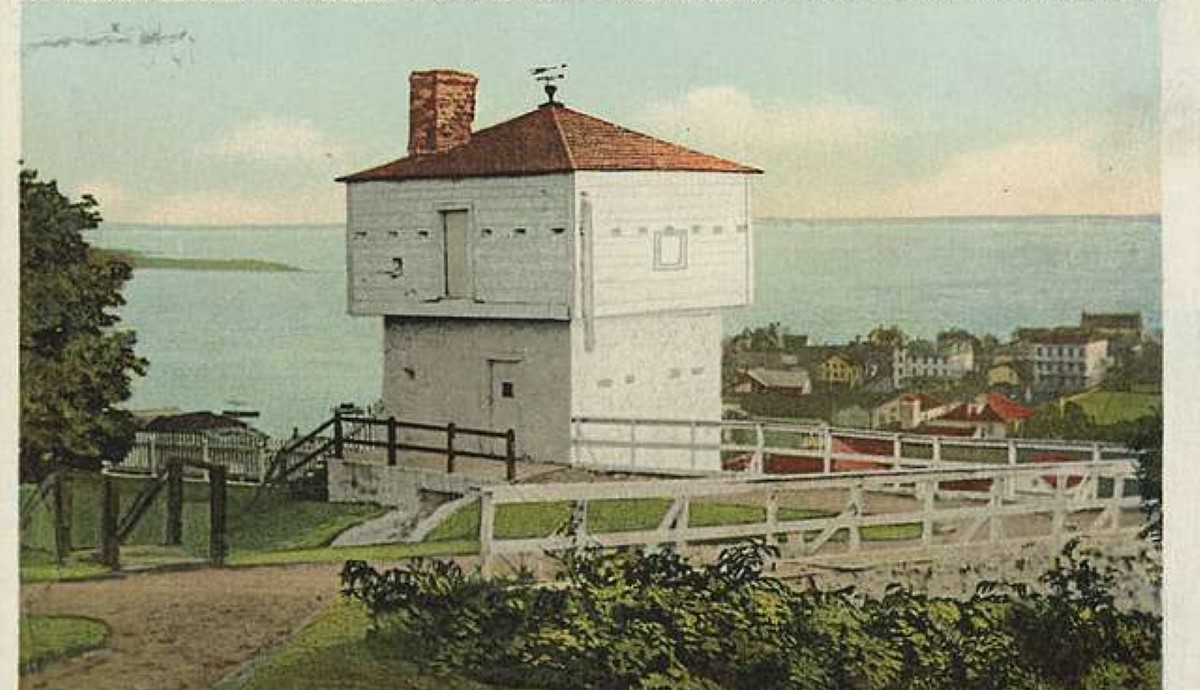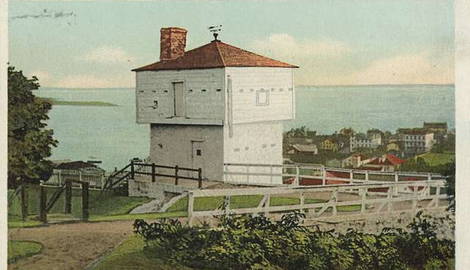
Michigan’s early development was shaped by its access to the Great Lakes and its importance in the fur trade, military defense, and westward expansion. Before statehood in 1837, it was part of the Northwest Territory and saw control shift between French, British, and American forces.
Mackinac Island, located where Lakes Huron and Michigan meet, was especially strategic. It became a key site for the British during the American Revolutionary War and was the focus of two major events during the War of 1812: the British capture of Fort Mackinac in 1812 and the failed American attempt to reclaim it in 1814.
Today, Mackinac Island is home to some of Michigan’s most important historic sites, many preserved as part of the state park system. These landmarks offer a detailed look at military operations, early settlement, Native American relations, the fur trade, and the island’s transformation into a 19th-century resort destination.
1. Fort Mackinac

Perched high above the harbor, Fort Mackinac stands as a powerful reminder of Mackinac Island’s military past. Built by the British in 1780 during the American Revolutionary War, the fort changed hands between British and American forces multiple times and played a key role in the War of 1812. Today, it’s one of the island’s most iconic landmarks, beautifully preserved and rich in historical detail.
Visitors can wander through original stone buildings, including the soldiers’ barracks, the guardhouse, and the officers’ quarters, all restored to their 19th-century appearances. Live cannon and rifle demonstrations bring the past to life, and exhibits tell the stories of those who lived and served there. With sweeping views over the Straits of Mackinac, it’s also one of the island’s most scenic spots.
2. Fort Holmes

Tucked away at the highest point on Mackinac Island, Fort Holmes offers a quieter but equally meaningful chapter in the island’s story. Originally built by the British during the War of 1812, the fort was designed as a lookout and last line of defense against American forces. Though it was eventually abandoned and fell into ruins, Fort Holmes has since been carefully reconstructed, allowing visitors to step into a rare piece of wartime history.
Its remote location means fewer crowds and a more reflective atmosphere, perfect for those who enjoy walking trails, quiet exploration, and sweeping panoramic views. Informational panels explain the fort’s strategic role and the challenges of life stationed so far from the main post. The view alone, from the highest elevation on the island, is worth the climb.
3. Mission Church

Stepping inside Mission Church feels like entering a quiet echo of Mackinac Island’s early spiritual life. Built in 1829 by Protestant missionaries, it’s the oldest surviving church in Michigan and one of the most historically significant buildings on the island.
Unlike the island’s military forts, Mission Church tells a gentler story: one of faith, education, and community. With its simple New England-style design, white clapboard exterior, and wooden pews, the church has been carefully restored to reflect its 1830s appearance. It’s a place where island residents once gathered for worship, weddings, and public meetings.
Today, you can pause in the serene space, admire the architecture, and learn about the efforts to bring Christianity and literacy to the area’s Native and French communities. Tucked in a peaceful corner of town, Mission Church offers a welcome contrast to the busier tourist stops.
4. Biddle House

The Biddle House is one of Mackinac Island’s oldest residences, dating back to the late 1700s, and it tells a layered story of fur trade, family life, and cultural blending.
Once home to Edward Biddle, a successful fur trader, and his Ojibwa wife Agatha, the house stands as a rare window into the lives of Métis families, those of mixed Indigenous and European ancestry.
It has been thoughtfully restored and transformed into the Mackinac Island Native American Museum. Visitors can explore the beautifully preserved rooms while discovering the traditions, artistry, and resilience of the Anishnaabek people.
Exhibits focus on Native contributions to the fur trade, daily life, and the enduring legacy of Indigenous culture in the Great Lakes region.
5. Robert Stuart House

Built in 1817, this modest Federal-style home was once the residence of Robert Stuart, agent for John Jacob Astor’s powerful American Fur Company. At a time when Mackinac Island was the hub of the fur trade, Stuart managed one of the most influential operations in the Great Lakes region from this very house.
Today, the building serves as a quiet museum, offering a glimpse into domestic life during the island’s fur trade era. Original furnishings, period décor, and thoughtful exhibits reveal how business, family, and frontier living intersected.
The house also hosted important guests, including military officers and company traders, making it a center of both commerce and conversation. It’s not grand, but that’s part of the charm: the Robert Stuart House gives you the feeling of stepping into someone’s everyday life more than 200 years ago, where the island’s global connections once started with a knock at the front door.
6. Grand Hotel

The Grand Hotel is a living symbol of Victorian elegance perched on Mackinac Island’s bluffs. Since opening in 1887, it has welcomed U.S. presidents, dignitaries, authors, and film crews, all drawn to its timeless charm and unmatched setting.
Its famed front porch, the longest in the world, offers sweeping views of the Straits of Mackinac and invites guests to slow down in rocking chairs with a lemonade or cocktail in hand.
Inside, every detail, from the vibrant wallpaper to the antique furnishings, tells a story of grandeur and tradition. Visitors don’t need to book a room to feel the magic; daily tours, afternoon tea, and garden strolls offer a taste of the experience. And for fans of the 1980 film Somewhere in Time, the hotel is a cinematic pilgrimage site.
7. The Richard & Jane Manoogian Mackinac Art Museum

The Richard & Jane Manoogian Mackinac Art Museum is a cultural gem nestled within Mackinac Island’s historic Indian Dormitory, a Federal-style building constructed in 1838. Originally built to house Native Americans visiting the island, the structure has served various roles over the years, including as a public school and a museum of Native American culture. In 2010, after extensive renovations funded by the Manoogian Foundation, it reopened as an art museum dedicated to showcasing Mackinac-inspired art through the ages.
The museum’s diverse collection spans centuries, featuring hand-beaded Native American garments, 17th and 18th-century maps of the Great Lakes, and Victorian-era decorative arts. Photography enthusiasts will appreciate the works of William H. Gardiner, known for his early 20th-century hand-tinted views of the island. Families can engage in creative activities at the Kids’ Art Studio, open from early June to late August, where children can explore art through various mediums.
Located within Marquette Park, just below Fort Mackinac, the museum offers a serene setting to explore the island’s artistic heritage.
8. Anne’s Tablet

Tucked away on a wooded bluff above Marquette Park, Anne’s Tablet is one of Mackinac Island’s most poetic and quietly powerful landmarks.
Installed in 1916, this bronze Art Nouveau tablet honors Constance Fenimore Woolson, a 19th-century author and native of Cleveland who spent summers on the island and found inspiration in its scenery.
The tablet sits near the site where Woolson is believed to have written her novel Anne, and the view, lush greenery opening up to a sweeping vista of the harbor, captures the mood of her storytelling.
Unlike the grander historic sites on the island, Anne’s Tablet is intimate, even a little hidden, which adds to its charm. Stone benches and winding paths invite visitors to pause, reflect, and imagine a writer’s voice carried by the breeze.










